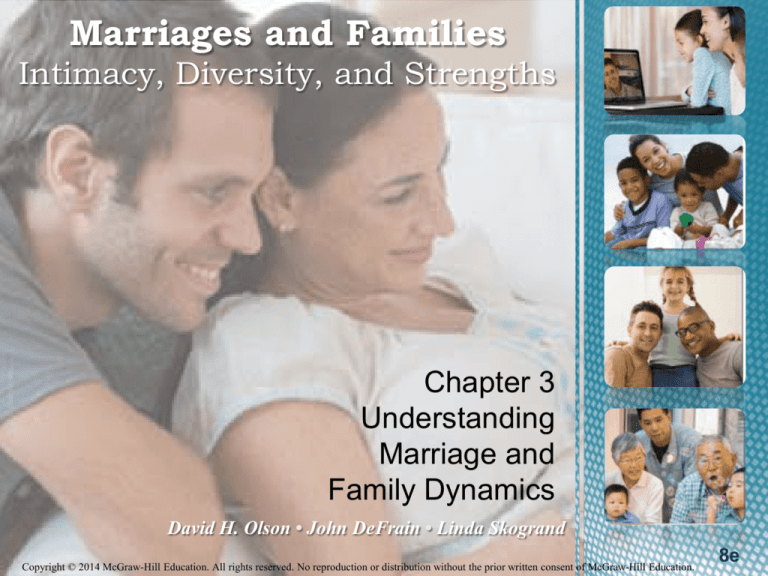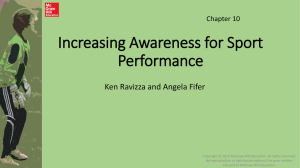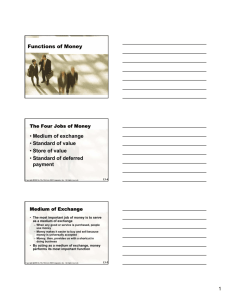
Marriages and Families
Intimacy, Diversity, and Strengths
Chapter 3
Understanding
Marriage and
Family Dynamics
David H. Olson • John DeFrain • Linda Skogrand
Copyright © 2014 McGraw-Hill Education. All rights reserved. No reproduction or distribution without the prior written consent of McGraw-Hill Education.
8e
The history of family science
Models of couples and families
Three key relationship concepts
Couple and family map
Dynamics change in relationships over time
Copyright © 2014 McGraw-Hill Education. All rights reserved. No reproduction or distribution without the prior written consent of McGraw-Hill Education.
3-2
Conceptual framework: Helps organize
thinking from a particular perspective
through a set of interconnected:
Concepts
Ideas
Assumptions
Theory: General principles composed of
interrelated concepts
Copyright © 2014 McGraw-Hill Education. All rights reserved. No reproduction or distribution without the prior written consent of McGraw-Hill Education.
3-3
Hypotheses: Presumed relationships
between variables
Research study: Designed to test one or
more specific hypotheses
Eclectic approach - Open-minded approach
to learning and to life
Very open and accepting of contradictory ideas
Copyright © 2014 McGraw-Hill Education. All rights reserved. No reproduction or distribution without the prior written consent of McGraw-Hill Education.
3-4
Idiographic approach
• Focuses on the unique aspects of
individuals or families
Nomothetic approach
• Focuses on ideas that apply to the
majority of individuals or families
Copyright © 2014 McGraw-Hill Education. All rights reserved. No reproduction or distribution without the prior written consent of McGraw-Hill Education.
3-5
The National Council on Family Relations
(1938) - Focuses on:
Family research
Practice
Education
American Association for Marital and Family
Therapy (1942) - Focuses on:
Increasing understanding, research, and
education
Copyright © 2014 McGraw-Hill Education. All rights reserved. No reproduction or distribution without the prior written consent of McGraw-Hill Education.
3-6
Helping individuals, couples, and families with
problems
Eugenics: Breeding to improve inherited
characteristics
Copyright © 2014 McGraw-Hill Education. All rights reserved. No reproduction or distribution without the prior written consent of McGraw-Hill Education.
3-7
Copyright © 2014 McGraw-Hill Education. All rights reserved. No reproduction or distribution without the prior written consent of McGraw-Hill Education.
3-8
Family systems theory
Family strengths framework
Family development framework
Symbolic interaction framework
Social construction framework
Feminist framework
Copyright © 2014 McGraw-Hill Education. All rights reserved. No reproduction or distribution without the prior written consent of McGraw-Hill Education.
3-9
Focuses on the family as an ongoing system
of interconnected members
Family system: Group in which family members
are interconnected and operate together
Evolved from the general systems theory
General systems theory: Set of principles and
concepts that can be applied to all types of
systems, living and nonliving
Created by family therapists who realized
that working with an individual alone did
not produce long-term change
Copyright © 2014 McGraw-Hill Education. All rights reserved. No reproduction or distribution without the prior written consent of McGraw-Hill Education.
3-10
Multiple system levels: Systems are
embedded within other systems
Suprasystem: Encompasses the larger
component of a system
Subsystem: Encompasses the dyadic unit of a
system
Boundaries: Connect and separate a system
from other systems
Copyright © 2014 McGraw-Hill Education. All rights reserved. No reproduction or distribution without the prior written consent of McGraw-Hill Education.
3-11
Copyright © 2014 McGraw-Hill Education. All rights reserved. No reproduction or distribution without the prior written consent of McGraw-Hill Education.
3-12
Ecology: Study of how all the organisms in
a system are related to each other
Human ecosystem: All the concentric
circles in a human system are
interconnected
People in each circle influence those in other
circles
Copyright © 2014 McGraw-Hill Education. All rights reserved. No reproduction or distribution without the prior written consent of McGraw-Hill Education.
3-13
Wholeness: Whole family is more than the
total of all its individual members
Interdependence of parts: Members of a
family are interconnected in such a way
that when one member changes, it affects
the others as well
Copyright © 2014 McGraw-Hill Education. All rights reserved. No reproduction or distribution without the prior written consent of McGraw-Hill Education.
3-14
Ability of a system to balance both stability
and change
Open system (morphogenic system): Open
to growth and change
Closed system (morphostatic system):
Avoids change by maintaining the status
quo
Copyright © 2014 McGraw-Hill Education. All rights reserved. No reproduction or distribution without the prior written consent of McGraw-Hill Education.
3-15
Centrifugal interactions: Increase
separateness by pushing family members
apart
Centripetal interactions: Increase family
closeness by pulling family members
together
Healthy balance of separateness and
connectedness works best for families in
crisis
Copyright © 2014 McGraw-Hill Education. All rights reserved. No reproduction or distribution without the prior written consent of McGraw-Hill Education.
3-16
Positive feedback: Intended to create
change
Negative feedback: Designed to minimize
change and keep things the same
Positive and negative feedback indicate
whether change occurs in the system or not
Copyright © 2014 McGraw-Hill Education. All rights reserved. No reproduction or distribution without the prior written consent of McGraw-Hill Education.
3-17
Focuses on how couples and families
succeed, from a global perspective
Strong families can serve as models for other
families wanting to succeed
Identifying a family’s strengths:
Can be the foundation for continued growth and
change
Boosts the morale of its members
Copyright © 2014 McGraw-Hill Education. All rights reserved. No reproduction or distribution without the prior written consent of McGraw-Hill Education.
3-18
Source: From John DeFrain and S. Asay (eds.), Strong Families Around the World: The Family Strengths Perspective.
Copyright © 2007 by The Haworth Press, Inc. Reprinted by permission of Taylor & Francis, Inc.
Copyright © 2014 McGraw-Hill Education. All rights reserved. No reproduction or distribution without the prior written consent of McGraw-Hill Education.
3-19
How family members deal with various roles
and developmental tasks within the family
As they move through stages of the life cycle
A member’s efficiency in completing the
tasks directly impacts the development of
the various family members
Copyright © 2014 McGraw-Hill Education. All rights reserved. No reproduction or distribution without the prior written consent of McGraw-Hill Education.
3-20
Advantages
Focuses on development and change in
individuals and the family over time
Encourages attention to process
Approaches the family as a dynamic system
Emerging adulthood: New stage of
development between childhood and
adulthood
From age18 to 25
Copyright © 2014 McGraw-Hill Education. All rights reserved. No reproduction or distribution without the prior written consent of McGraw-Hill Education.
3-21
Prolonged period of role exploration focusing on
identity
Time spent trying out career and relationship
possibilities
Useful for analyzing the stages of family life
Life course: Describes the transitions one
makes through life
More fluid
Reflects unpredictable changes
Copyright © 2014 McGraw-Hill Education. All rights reserved. No reproduction or distribution without the prior written consent of McGraw-Hill Education.
3-22
Focuses on:
Symbols - Based on shared meanings
Interactions - Based on verbal and nonverbal
communication
Explains how people learn about roles by
communicating with each other
Family is seen as a unit of interacting
personalities
Copyright © 2014 McGraw-Hill Education. All rights reserved. No reproduction or distribution without the prior written consent of McGraw-Hill Education.
3-23
Role
• Expected behavior of a person or group in a
given social category
Role taking
• People learn how to play roles correctly by:
• Practicing
• Getting feedback from others
Role making
• Creating new roles or revising existing roles
Copyright © 2014 McGraw-Hill Education. All rights reserved. No reproduction or distribution without the prior written consent of McGraw-Hill Education.
3-24
Meaning arises in the process of interaction
between people
Definition of the situation: Each person subjectively
interprets a given situation
People learn about themselves and develop a
self-concept based on interaction with others
Looking-glass self: Learning about oneself based on
the feedback received from others
Copyright © 2014 McGraw-Hill Education. All rights reserved. No reproduction or distribution without the prior written consent of McGraw-Hill Education.
3-25
Human beings are immersed in the social
world
Our understanding and beliefs are social products
Individuality - Difficult to develop in a social
environment
Identities are shaped over time through life
experiences
Copyright © 2014 McGraw-Hill Education. All rights reserved. No reproduction or distribution without the prior written consent of McGraw-Hill Education.
3-26
Compatible with postmodernist and
multicultural intellectual movements
Postmodernism: Emphasizes that we live in a
complex world
Knowledge-positions - Various perspectives on life that we
encounter
Copyright © 2014 McGraw-Hill Education. All rights reserved. No reproduction or distribution without the prior written consent of McGraw-Hill Education.
3-27
Society should commit to empowering
women and changing their oppressed
condition
Feminist movements
First wave - Right to vote
Second wave - Collectivist approach
Third wave - Individualistic approach
Gender: Learned behaviors and
characteristics associated with being male
or female in a particular culture
Copyright © 2014 McGraw-Hill Education. All rights reserved. No reproduction or distribution without the prior written consent of McGraw-Hill Education.
3-28
Feminist theories examine gender
differences and their justification of power
differences between the genders
Challenges the definition of family based on
traditional roles
Instrumental role: Being in charge of tasks
Played by the male
Expressive role: Being nurturing
Played by the female
Copyright © 2014 McGraw-Hill Education. All rights reserved. No reproduction or distribution without the prior written consent of McGraw-Hill Education.
3-29
Multicultural feminism
Focuses on women’s prosperity in developed
nations
Criticism - Achieved at the expense of women
in developing nations
Ecofeminism: Domination of nature or the
nonhuman world
Copyright © 2014 McGraw-Hill Education. All rights reserved. No reproduction or distribution without the prior written consent of McGraw-Hill Education.
3-30
Copyright © 2014 McGraw-Hill Education. All rights reserved. No reproduction or distribution without the prior written consent of McGraw-Hill Education.
3-31
Copyright © 2014 McGraw-Hill Education. All rights reserved. No reproduction or distribution without the prior written consent of McGraw-Hill Education.
3-32
Copyright © 2014 McGraw-Hill Education. All rights reserved. No reproduction or distribution without the prior written consent of McGraw-Hill Education.
3-33
Family communication is linear
Better the communication skills, stronger the
family relationship
Copyright © 2014 McGraw-Hill Education. All rights reserved. No reproduction or distribution without the prior written consent of McGraw-Hill Education.
3-34
Copyright © 2014 McGraw-Hill Education. All rights reserved. No reproduction or distribution without the prior written consent of McGraw-Hill Education.
3-35
Built on the major dimensions of cohesion,
flexibility, and communication
Built on principles and concepts from family
systems theory
Has features in common with other frameworks
Copyright © 2014 McGraw-Hill Education. All rights reserved. No reproduction or distribution without the prior written consent of McGraw-Hill Education.
3-36
Copyright © 2014 McGraw-Hill Education. All rights reserved. No reproduction or distribution without the prior written consent of McGraw-Hill Education.
3-37
Copyright © 2014 McGraw-Hill Education. All rights reserved. No reproduction or distribution without the prior written consent of McGraw-Hill Education.
3-38
Function more adequately across the family
life cycle
Families with:
Balanced cohesion - Allow members to be
independent from and connected to them
Balanced flexibility - Maintain stability while
being open to change
Copyright © 2014 McGraw-Hill Education. All rights reserved. No reproduction or distribution without the prior written consent of McGraw-Hill Education.
3-39
Provides a common descriptive language for
talking about real couples and families
Concepts and ideas from three major
frameworks
Family systems, family strengths, and family
development
Helps describe how relationships change as
challenges appear
Turns concepts into working themes so
family dynamics can be measured
Copyright © 2014 McGraw-Hill Education. All rights reserved. No reproduction or distribution without the prior written consent of McGraw-Hill Education.
3-40
Copyright © 2014 McGraw-Hill Education. All rights reserved. No reproduction or distribution without the prior written consent of McGraw-Hill Education.
3-41







